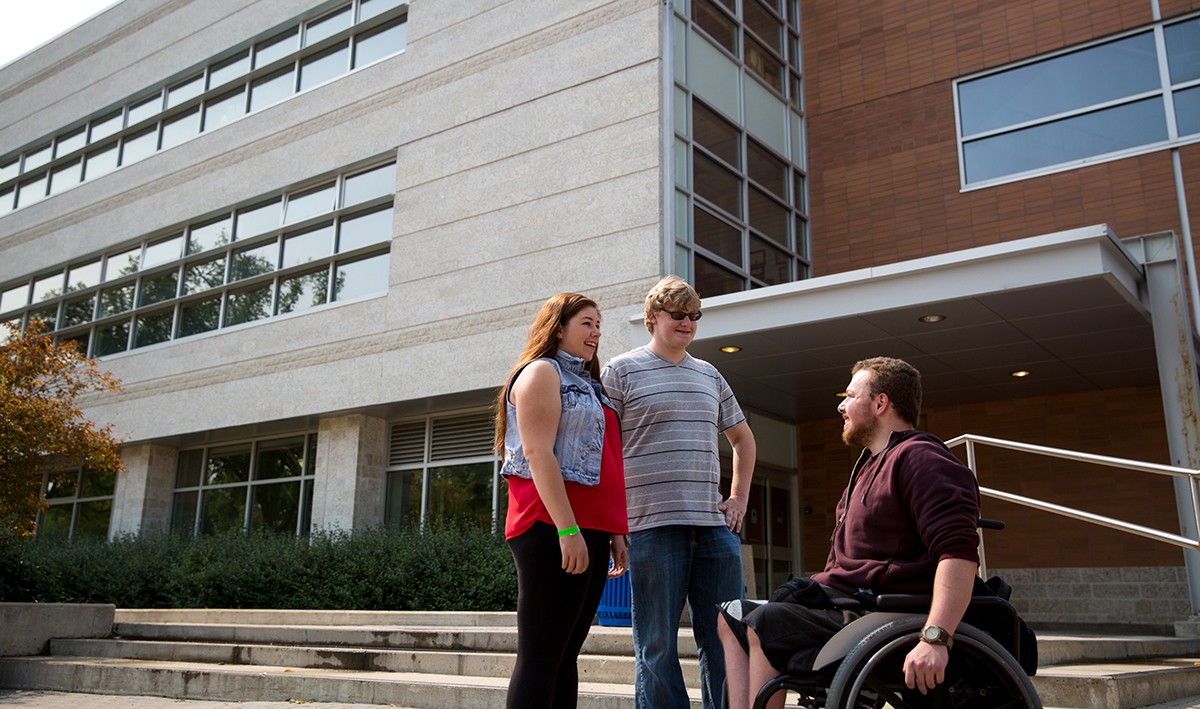
Planning for accessibility: Beyond the law
Inclusive design specialist on how accessibility works for all
It’s ugly. It costs more. It conflicts with security protocols. It offers no competitive advantages. It benefits only those with disabilities.
These are a few of the myths about inclusive design that need to be combatted with facts, says director of the Inclusive Design Research Centre at OCAD University, Jutta Treviranus. Of the facts, it’s significant that one in five of us will experience a disability at some time in our lives, she points out — which means that all of us should consider how to make our environment more accessible and inclusive.
Treviranus visited the U of M on Tuesday, March 15 to speak to Manitobans about inclusive design principles in light of the Accessibility for Manitobans Act, which became legislation in December 2013. The event was hosted by the Accessibility Network of Post Secondary Institutions, the Office of Human Rights and Conflict Management and other partners across campus.
Five new standards are intended to achieve substantially higher levels of accessibility in Manitoba; customer service is the first standard for development. All standards created under the Act apply to the provincial government, the broader public sector, and the private and not-for-profit sectors in Manitoba.
In 2016, and every second year thereafter, the Act will require the University of Manitoba to prepare accessibility plans that address the identification, prevention, and removal of barriers.
The law, says Treviranus, is just the first step.
What comes after the law? Our choices
Now that the AMA has passed into law, the public sector is working towards implementing the new standards, the first of which (customer service) must be met by 2017.
To help with this large undertaking, the University of Manitoba, alongside other Manitoba universities and colleges, formed an Accessibility Network of Post Secondary Institutions in order to collaborate on implementation.
Recruiting the community to help and participate together, says Treviranus, allows everyone to work together towards building solutions that start as “incomplete, impermanent and imperfect,” pooling resources and even providing a public repository for data, information, knowledge and wisdom.
As she notes, “Since laws are not agile, our choices within the law are important.” She emphasizes the importance of responsive, iterative solutions that focus on collaboration among diverse perspectives.
The “fail early and often” approach also has distinct “learning advantages” — along with an approach that rewards and highlights exemplars and progressive effort,” she says.
According to Treviranus, “Designing for diversity [is] enlightened self-interest.” Assistive technologies (AT), though helpful, are not enough. They also entail an impossible technical task in trying to cover compatibility with all systems. Our design approach needs to go beyond meeting needs of the (non-existent) “average” user to become “design that considers the full range of human diversity with respect to ability, language, culture, gender, age and other forms of human difference,” she says.
Instead, and unlike AT, proactive inclusive design costs less because it considers at the outset a whole range of abilities. Inclusive design improves usability, increases customer satisfaction and loyalty and competitive advantage.
And of course, she adds, inclusion is ultimately better for our communities: for our families, for those around us, for ourselves.
Integration over segregation
There are three dimensions of inclusive design Treviranus suggests: Keep the process systemic or pervasive (with “virtuous” rather than “vicious” cycles), participatory and personal — thereby supporting personalization and co-design, and emphasizing integration over segregation.
Why participatory co-design? Because “diversity trumps ability.” Participatory design is bigger, more connected, more complex — allowing for more successful planning, more accurate prediction and greater creativity than isolated approaches. She suggests a focus on the tools and systems rather than the “instance,” through authoring tools, creating and sharing templates and development tools, and changing internal processes and procurement language.
Platforms that can help support an “inclusive culture change,” she says:
- engage many stakeholders
- match demands with supply, pool resources, tools and exemplars
- provide a public repository for data, information, knowledge and wisdom
- draw on an ever-growing and diverse community of practice
- provide training for skills, competencies and expertise
- engage the community
- use bottom-up verification, recruit the community
- reward and highlight exemplars and progressive effort
- are fueled by use and collective production
She also suggests engaging compliance support tools, training, human capacity and reporting support.
The merits of accessibility and inclusion are no longer something to debate anymore, Treviranus says: “the evidence is irrefutable, it affects all of us, the health of our society depends upon it.”
It’s now time, she adds, to shift the focus from the “why” to the “how.”
Resource Links
Web Content Accessibility Guidelines (WCAG) 2.0: http://www.w3.org/TR/WCAG/
WebAIM and WAVE Evaluation Tool: http://webaim.org/
Office Documents: Accessible Digital Office Documents (ADOD): http://adod.idrc.ocad.ca
Mobile Apps (BBC Guidelines): http://www.bbc.co.uk/guidelines/futuremedia/accessibility/mobile
The Example of Microsoft: https://www.microsoft.com/en-us/design/inclusive
Contact: Human [dot] Rights [at] umanitoba [dot] ca
>> See also: “Planning for accessibility: Resources”






